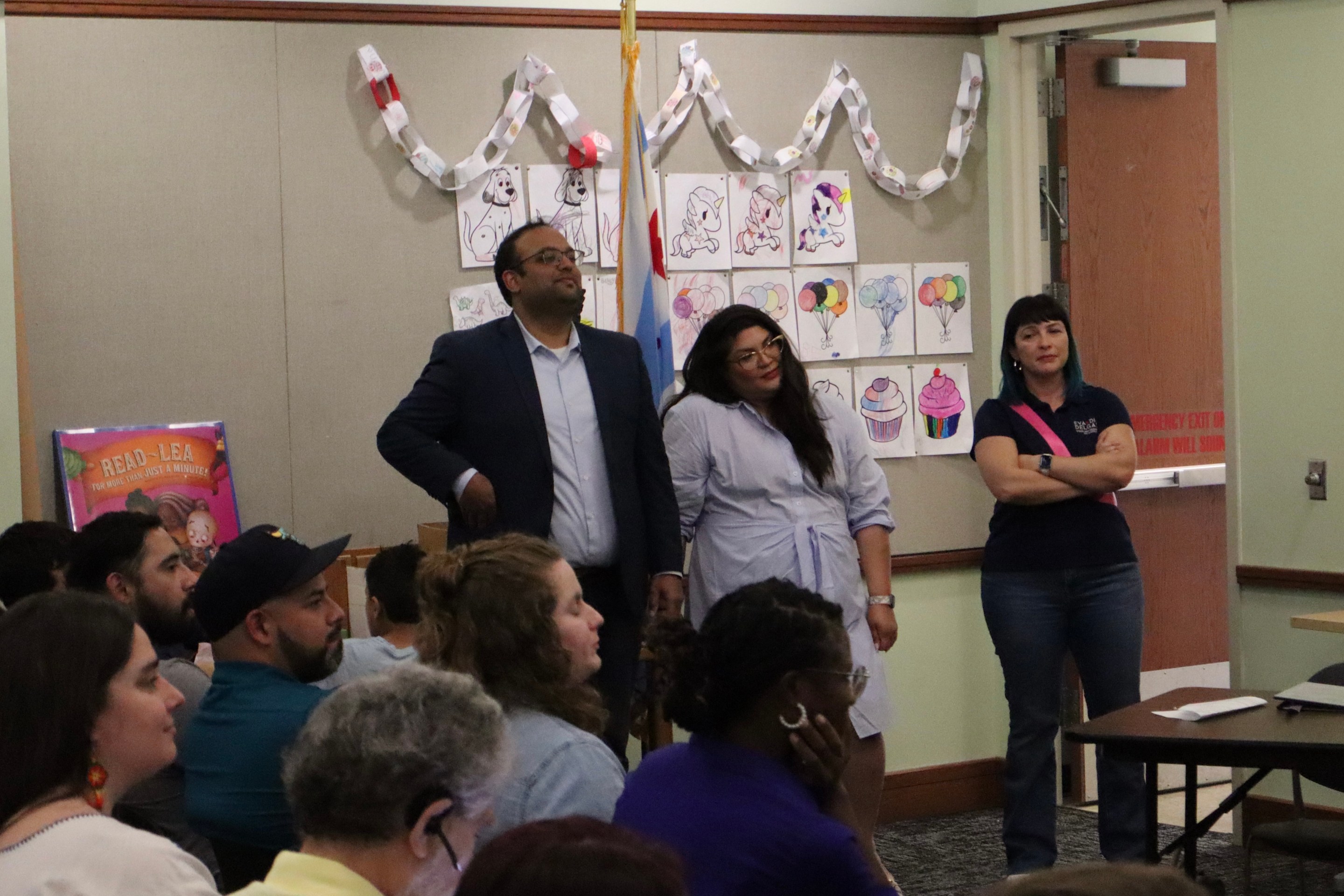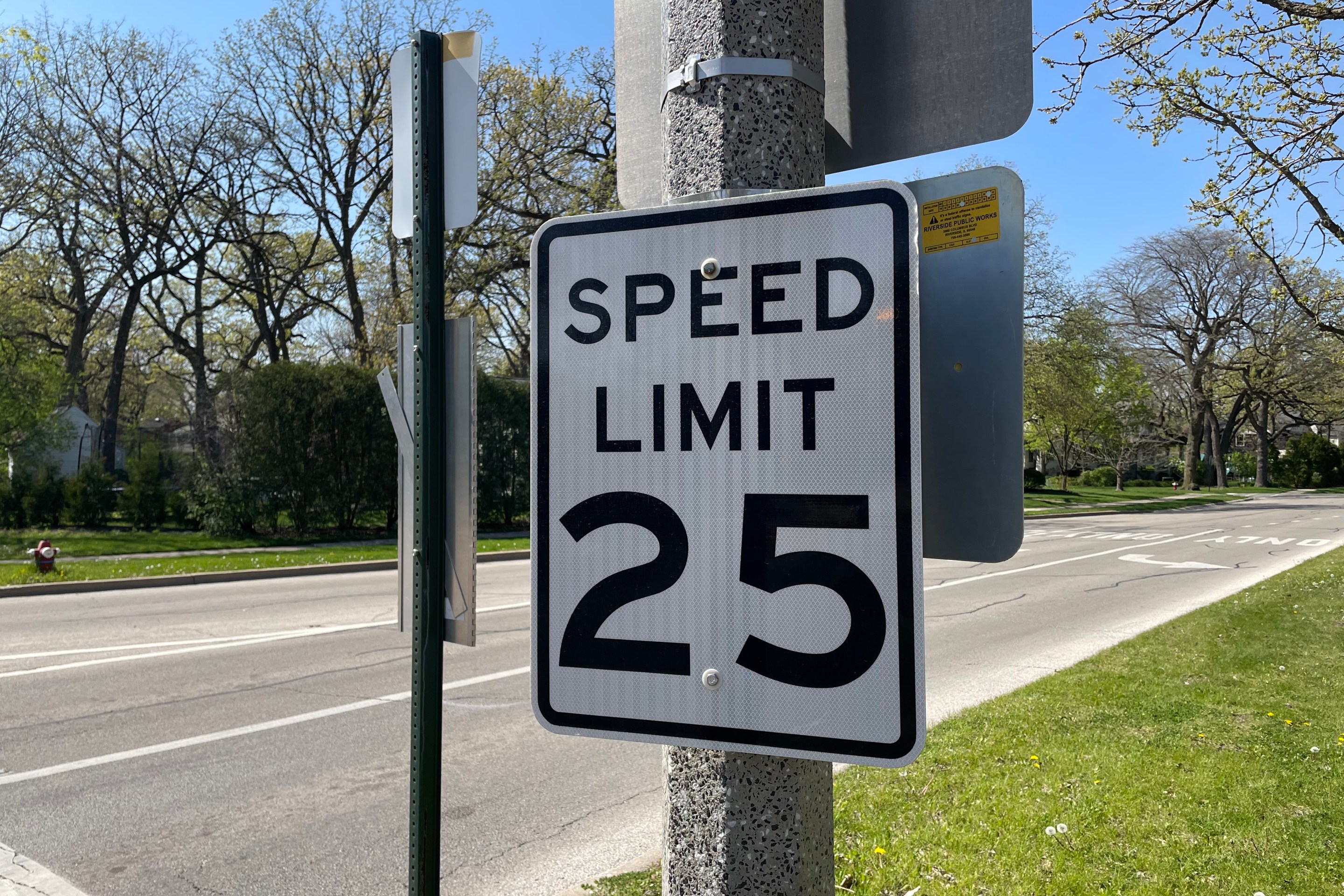At meeting on popular Dickens Greenway plan, Ald. Smith complains about “bad cyclists”
5:52 PM CDT on May 19, 2021
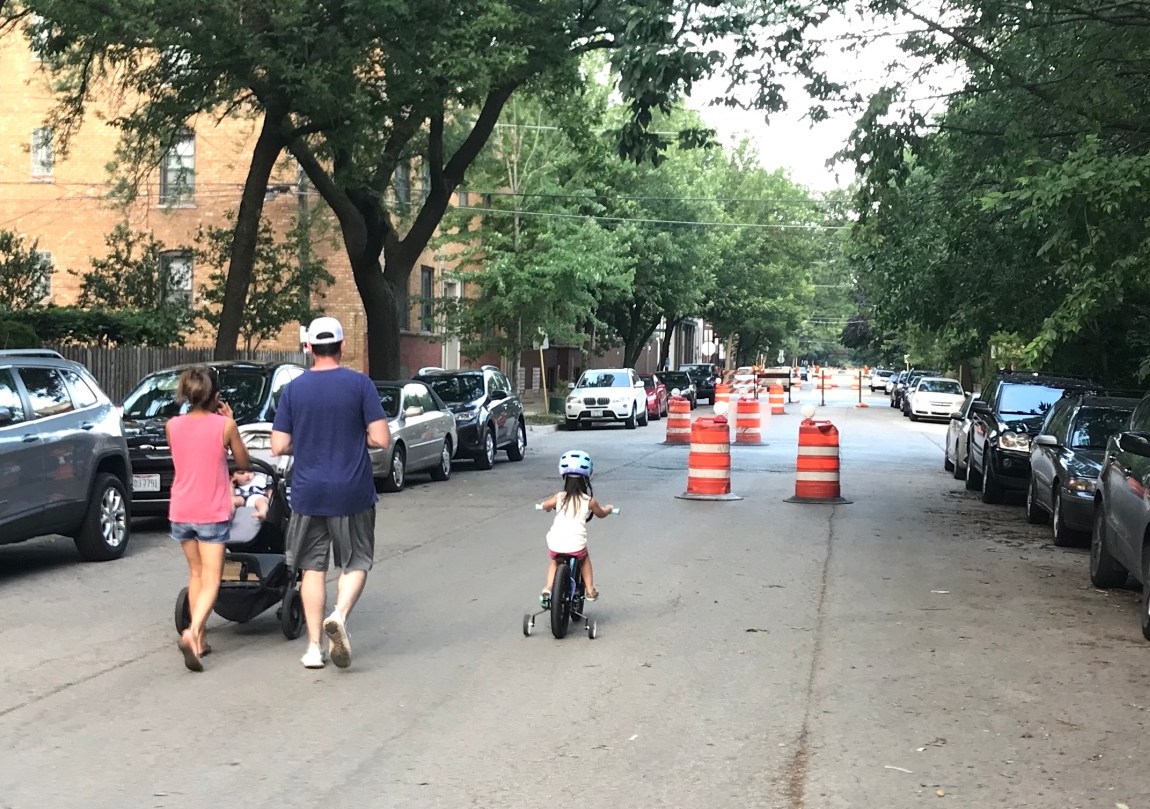
The Dickens Avenue Slow Street. Photo: John Greenfield
On Tuesday night Alderman Michele Smith of the 43rd ward convened a public meeting over Zoom about the two-years-old proposal to convert part of Dickens Avenue in Lincoln Park into a "Neighborhood Greenway." Chicago Department of Transportation bicycle and pedestrian program manager David Smith presented plans for the greenway and answered questions from the audience. It was a well-attended meeting with 166 people in attendance when the Q & A period began around 90 minutes into the meeting. At the beginning of the meeting it was clear that many people had already formed their opinions about the greenway.
Alderman Smith began by saying that she was not a fan of the Dickens Slow Street – a pilot project last year that used barricades and traffic barrels to ban motorized through traffic and calm local traffic to allow for safe, socially-distanced walking and biking in the street. She argued that it had been poorly executed, causing lots of problems for people who drive.

Attendees were given the opportunity to register as being supporters or opponents of the greenway proposal. Audience members were also allowed to “like” questions or comments they agreed with. The chat function was disabled but plenty of comments were provided in the Q & A section of the Zoom app. Some neighbors have raised concerns about outsiders entering their tony Lincoln Park enclave and unfounded claims that pedestrians will be at risk of being hit by cyclists. We debunked some of those arguments in an August 2019 article, noting that CDOT data shows that while other Chicago Neighborhood Greenways have increased bike traffic, they've simultaneously decreased traffic crashes.
David Smith began his presentation by speaking about the goals for the Dickens Greenway: improving pedestrian safety and comfort, organizing the street to accommodate people who are already contraflow cycling on the one-way westbound street, and providing consistent and predictable vehicle speeds. He noted that cycling is the fastest growing transportation mode in Chicago, including in Lincoln Park.
The Dickens Greenway would include a contraflow bike lane to legalize eastbound cycling, lowering the speed limit to 20 mph, sidewalk extensions, speed humps, and raised crosswalks to calm motorized traffic and make walking safer and easier. Feedback from the August 2019 meeting (which Streetsblog Chicago covered) and conversations with officials and parents at St. James Lutheran School shaped the added components to the greenway.
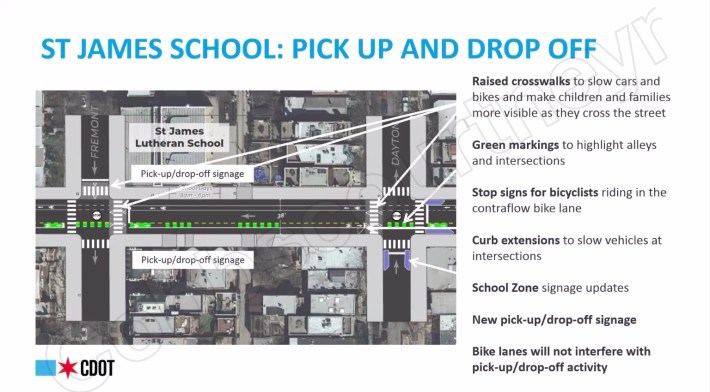
Raised crosswalks, green markings at alleys and intersections, school zone signs and markings, and new pick-up and drop-off signs will be added to the 800 block of West Dickens near St. James. Attendees were advised that the contraflow bike lane will not interfere with pick-up & drop-off activity. Based on feedback from the last public meeting, CDOT is now proposing to widen the contra-flow bike lane to allow for better visibility of cyclists and add dashed bike lane lines at intersections where drivers can make right turns. The dashes will make it clear that turning drivers can cross the bike lane.
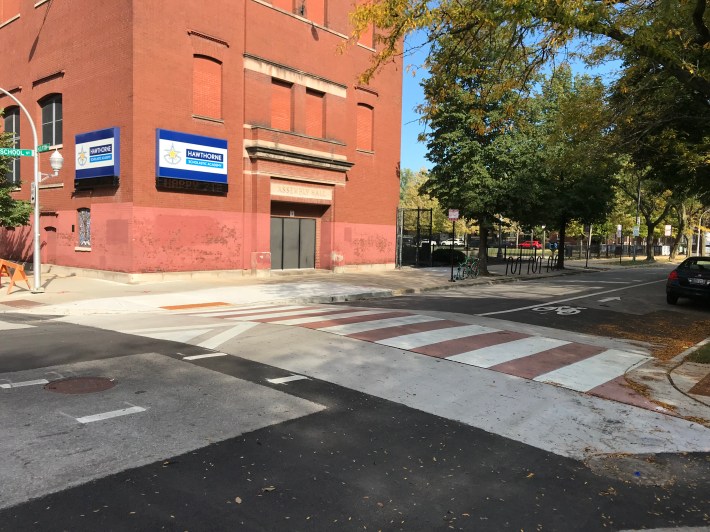
CDOT presented a breakdown of public comments from the August 2019 Dickens Greenway meeting. Sixty-four percent of public comments were in support of the Greenway, 32 percent were against it, and 4 percent were neutral. Key themes emerged from the feedback CDOT received. Those who are supportive of the Greenway cited the need to get around the neighborhood safely, the formalization of an already popular cycling route, and the desire for a safer connection to Oz Park. Comments against the Greenway cited concerns about people from other parts of the city entering the neighborhood, fear of it becoming a “bicycle highway”, and desires to limit the amount of cyclists coming to Oz Park.
Part of the Dickens Greenway will improve connections to Oz Park. CDOT will be adding a bicycle only ramp to the entrance of Oz Park with a sharp turn in the route that will force cyclists to slow down. See image below.
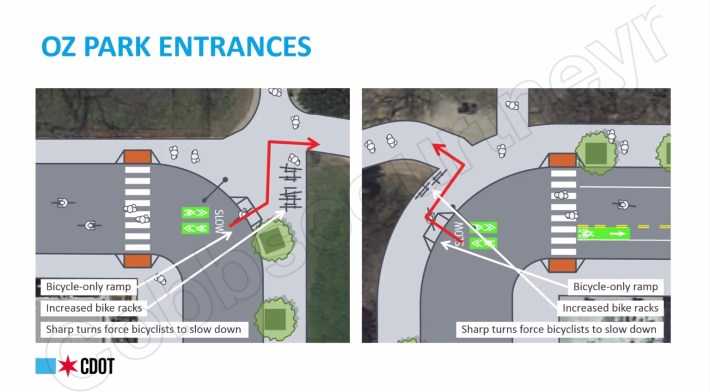
CDOT also plans to more than double bike parking throughout the park and at Lincoln Park High School, located just south. The department presented data that Oz Park is already popular destination for people biking and that bike riders are already being respectful to pedestrians when they pedal on the multi-use paths.
During last summer's Dickens Slow Street pilot, CDOT staff observed how people were using the street. David Smith discussed their findings:
- Far more pedestrians used the Slow Street than cyclists
- There was less bicycle traffic on Dickens compared to other shared streets
- Dickens did not take the place of Armitage bike lanes (277 bikes were observed on Dickens during a 24 hour period compared to 520 on Armitage)
- Even with the Slow Street treatment, there were still fewer people biking on Dickens than typically drive on the street
- Drivers and bike riders need to safely coexist
- Oz Park is a destination, not a throughway
- Aesthetics matter – Alderman Smith and CDOT received criticism about “ugly traffic barrels”
David Smith addressed many of the comments from audience members by stating, “We need to get out of our silos. This is not about bikes versus cars or cars versus bikes. Plenty of people who bike also drive. We want to create streets that are safe no matter how you get around.”
Attendees had a number of questions about the impact on car parking. David Smith stated many times during the meeting that there will be little to no impact on parking. A number of folks also voiced concerns about whether or not cyclists will stop at stop signs. David Smith stated that the majority of cyclists will obey the planned stop signs and that cyclist-pedestrian crashes are rare and involve minor injuries compared to crashes that involve vehicles. There were also a number of supporters on the call as well.
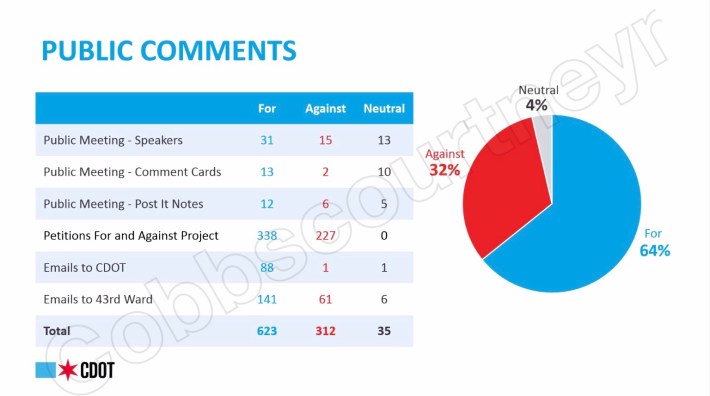
If the Dickens Greenway is approved, after it is completed CDOT SAFE (Streets Are For Everyone) Ambassadors will do outreach on the corridor to discuss safe behaviors and responsibilities with all users. They'll help families understand how to safely bike on the street, educate drivers on the new layout and their responsibility to drive safely, and talk to bicyclists about their need to ride considerately.
Alderman Smith later commented that she wanted police officers to come out and ensure that cyclists stop at stop signs. She added that, “Every one of us has experienced a bad cyclist” and that she would like to see the city require licensing and registration for cyclists.
I am perplexed at the implication it is cyclists who need more regulation, since drivers are the road users who regularly cause death and destruction on our streets. I was astonished that Alderman Smith voiced lots of anti-bike sentiments during the meeting. I was particularly outraged that Alderman Smith wants to send out armed police officers to ensure people on bikes come to a complete stop at stop signs. It's a complete waste of city resources and it puts Black and Brown cyclists at risk of being racially profiled and/or killed by a police officer.
At the end of the three-hour meeting I was left even more frustrated that simple projects like the Dickens Greenway which aim to increase safety for people walking and biking are subject to public approval. If we are serious about ensuring no one is seriously injured or killed in a traffic crash, we must ensure every street has the safety of vulnerable road users in mind. We cannot get there if every proposal has to be approved by a public that overwhelming drives and resists change that will ultimately benefit us all.
Alderman Smith is not alone in wanting to license cyclists. Alderman Pat Dowell has also proposed a licensing scheme for bicyclists in Chicago, back in 2013, as a revenue-raising idea. After we explained bike licensing costs more than it brings in while discouraging people from riding bikes, the Chicago Tribune wrote an editorial supporting Dowell’s idea and we debunked it again. John Greenfield wrote:
However, as has been shown in city after city, as bike mode share grows, the crash rate drops due to the safety-in-numbers factor. Cyclists become more visible, so that drivers learn to check for bikes before making a turn or opening a car door. If motorists are scared to death of hitting someone on a bike, that’s a good thing because it causes them to drive more cautiously, which benefits all road users.
At the end of the meeting, Alderman Smith was asked what the next steps are. She told the few remaining attendees that the 43rd Ward Office will continue gathering feedback on the proposed plan. If you would like to weigh in on the Dickens Greenway, you’re encouraged to email yourvoice@ward43.org.
Stay in touch
Sign up for our free newsletter
More from Streetsblog Chicago
State legislators pushing for merging CTA, Pace, and Metra into one agency spoke at Transit Town Hall
State Sen. Ram Villivalam, (D-8th) and state Rep. Eva-Dina Delgado (D-3rd), as well as Graciela Guzmán, a Democratic senate nominee, addressed the crowd of transit advocates.
Today’s Headlines for Tuesday, April 30
Equiticity and ATA: Passing a 25 mph speed limit should be combined with street redesigns that calm traffic
Equiticity, a mobility justice nonprofit, says the new speed limit shouldn't involve increased enforcement, which it says would disproportionately impact drivers of color
Johnson appoints one West Side pastor to CTA board, then nominates another West Side pastor for RTA board
Supporters argue that, despite his lack of transit expertise, Ira Acree’s social justice experience and political connections could be an asset for the RTA board.
